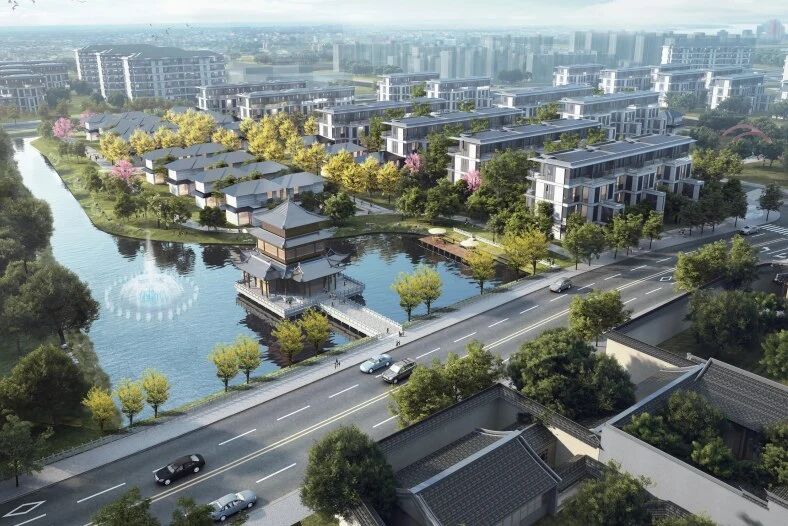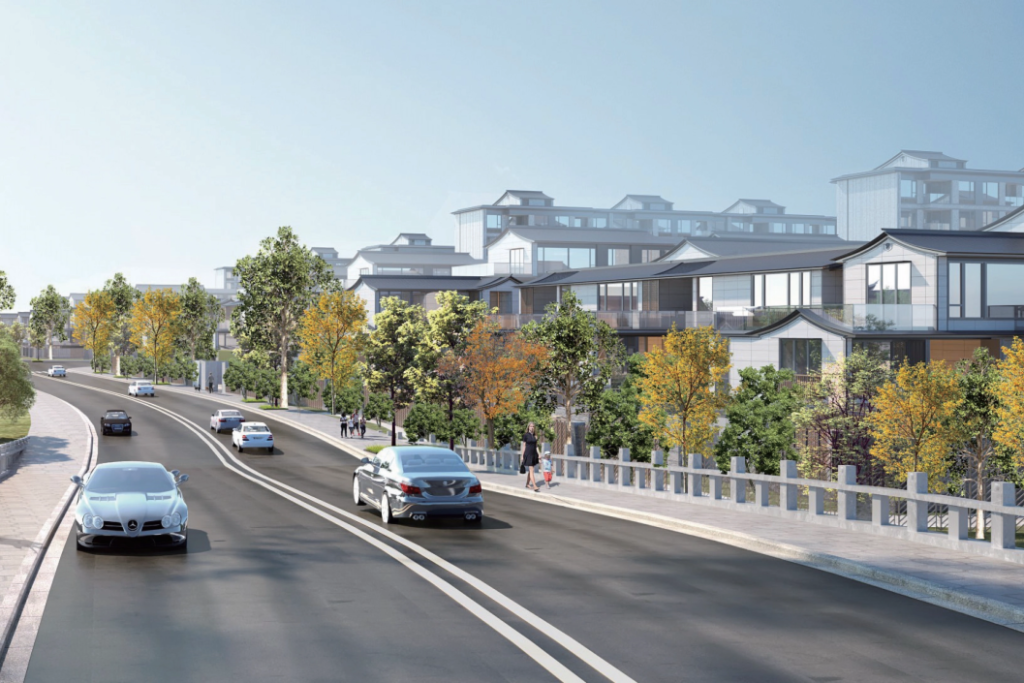Shui On Shanghai Zhao Jialou Revamp: “Retreat to Advance”?
Recently, there has been significant news in the field of urban renewal in Shanghai: the “Zhao Jialou Village Renovation Project,” previously developed by Shui On Land in partnership with Pujiang Town, has attracted new state-owned enterprise investors. According to information published on the Minhang District government website, Shanghai Nanhongqiao Investment Development Co., Ltd. submitted a request to the Minhang District State-owned Assets Supervision and Administration Commission (SASAC) in January 2025 to audit and assess Shanghai Zhao Lou Tiandi Co., Ltd. as part of its plan to acquire a 30% stake in the company and participate in the urban renewal work related to the Zhao Jialou project.Shui On Land’s “Retreat to Advance” Strategy.It is reported that the 30% equity transaction of the Zhao Jialou project will involve Shui On Land as the counterparty. Previously, the Zhao Lou Tiandi project was 90% owned by Shanghai Rui Lou Enterprise Management Co., Ltd. (a wholly-owned subsidiary of Shui On Land), with Pujiang Town holding a 10% stake. After the transaction is completed, Shui On Land will maintain a 60% shareholding and continue to lead the development and operation of the Zhao Lou Tiandi project.
This is not the first time Shui On Land has sold off assets it holds or plans to develop in recent years. In December 2023, it sold a 65% stake in the Shanghai Hong Shou Fang project to Hongrui Shouyuan, a subsidiary of Dajia Insurance, for 1.206 billion yuan; in March 2024, it sold the Shanghai Panlong Tiandi Hotel property to Shanghai Qingpu Xujing for 105 million yuan and signed a 14-year leaseback agreement, with total rent amounting to approximately 77 million yuan; and in November 2024, it raised 8.1 billion yuan by introducing investors, including China Life Insurance, to restructure the equity of two project companies under the Shanghai Chuangzhi Tiandi brand.These series of “financing” actions highlight Shui On Land’s urgent need for cash flow. During the 2024 mid-term performance meeting, the company’s CFO and Chief Investment Officer, Sun Xihui, stated, “Ensuring adequate liquidity remains our top priority.” Unlike domestic property developers who have faced frequent crises, Shui On Land has not fallen into the fatal trap of high turnover. However, the characteristics of Hong Kong enterprises—”heavy assets, high standards, and slow development”—have led to slower cash flow recovery.

Debt Repayment Pressure and Project Delays.Sun Xihui also mentioned that Shui On Land’s peak debt repayment period will be in 2025, with approximately 8.6 billion yuan in debt due for repayment. This debt pressure will inevitably impact the development progress of new projects, particularly large-scale projects like the Zhao Jialou project (with a total planned construction area of about 420,000 square meters) that involve high demolition costs. Although the current valuation of the project company is only 1.8 billion yuan, the total project investment is 12 billion yuan, and the 30% stake corresponds to 3.6 billion yuan.With the support of Nanhongqiao Group, Shui On Land’s initial capital investment in this project can be significantly reduced. Given Nanhongqiao Group’s background as a state-owned enterprise, this collaboration is likely not only motivated by support for Shui On Land or returns from the capital market but also by a political goal to expedite the project’s implementation.The Background of Nanhongqiao Group.Nanhongqiao Group, which joined the Zhao Jialou project, is a first-tier development company controlled by the Minhang District SASAC. Founded in 2015, it is primarily responsible for the development of the Minhang section of the Hongqiao International Business District.
The group has participated in key projects like the Hongqiao Vanke Center and Qianwan Impression City MEGA, excelling in industrial-city integration and regional planning. While Zhao Jialou is geographically distant from Nanhongqiao’s main area of focus, it is still part of Minhang District, and the stability of a state-owned enterprise in policy coordination and long-term investment, along with Nanhongqiao’s expertise in investment and development, is likely an important reason for advancing this collaboration.Zhao Jialou Old Town: Past and Present.Zhao Jialou Old Town is located in Ge Xin Village, Pujiang Town, Minhang District, east of the Pudong New Area, and west of the Huangpu River. It is only one kilometer away from the Shen Du Gong Road station of Metro Line 8. As the location where farming and land reclamation were encouraged during the late Yuan and early Ming dynasties, Zhao Jialou is known as the “birthplace of Shanghai’s farming culture.”Having developed through the Ming, Qing, and Republican periods, Zhao Jialou gradually became a typical water town in southern China, retaining 15 historical buildings such as Li Geng Tang and Mei Garden, as well as a 1-kilometer-long old street water system.
This picturesque town, with its blue bricks, gray tiles, and stone arch bridges, hides some of Shanghai’s most authentic traditional snacks, such as “chong ti,” lamb, and grasshead cakes. It is often considered “the living ancient town” and is one of the closest ancient towns to downtown Shanghai.In 2008, the renovation of Zhao Jialou Old Street began, completing in June 2010. In 2015, it was recognized as a historical and cultural preservation area and a national-level 4A scenic area. However, despite its geographical advantages, Zhao Jialou has not become as popular as other mature scenic spots like Zhouzhuang or Zhujiajiao. The relatively uniform business operations and tenant combinations have prevented it from establishing a distinct identity beyond its traditional “small bridges, flowing water, and rural homes.” Additionally, as a typical “urban village,” Zhao Jialou faces infrastructure challenges, with mixed commercial and residential properties. As tourism increases, issues like illegal construction, river occupation, and private house group rentals have also become more prevalent. For all these reasons, the renovation and upgrade of Zhao Jialou Old Town have become urgent.
In June 2022, the Zhao Jialou Village Renovation Project in Shanghai, previously developed by Shui On Land in collaboration with Pujiang Town, received the approval for the zoning regulation adjustment and a city-level “urban village” designation. To manage the renovation, Shanghai Zhao Lou Tiandi Co., Ltd. was established as the project’s implementing body. On February 6, 2023, the Zhao Jialou Old Town officially closed its doors to tourists. Just two months later, on April 20, Minhang District’s Pujiang Town and Shui On Land signed a formal agreement, marking the official launch of the Zhao Jialou “Urban Village” renovation project. As Shui On Land’s newest urban renewal project in Shanghai, the entire company has placed high expectations on the Zhao Jialou project.Shui On Land’s Strategic “Retreat to Advance”.At Shui On Land’s 2023 annual performance release, the company’s CEO, Wang Ying, stated: “The Zhao Jialou project has a richer history and natural resources compared to the Panlong project, and Shui On Land will leverage the successful experience from Panlong to empower business vitality through culture and enhance the site’s advantages and competitiveness.”Renovation Progress: Timeline and Acceleration.The renovation of Zhao Jialou covers an area of approximately 71 hectares, significantly larger than the current old town area.

The renovation will include three major functional zones: the Xiao Yan Lake leisure resort area, the old town core area, and the Gengxue health community. The total planned construction area is about 420,000 square meters, including 188,000 square meters of residential space (with a floor area ratio of 1.2), 164,000 square meters of commercial and office space, and 69,000 square meters of public service buildings. Given Shui On Land’s extensive experience in comprehensive development and cultural preservation across multiple cities and projects, the Zhao Jialou project is expected to become a landmark project on the eastern side of the Huangpu River.In fact, the Zhao Jialou project has already brought some unexpected surprises to Shui On Land during its acquisition process—particularly the “Ri Yue Nian Gao Shop” from Zhao Jialou Old Town, which had to close due to the town’s shutdown. The shop, now renamed “Nian Zhi Gao,” opened at the Panlong Tiandi project and has quickly garnered attention. According to reports from Shanghai Hotline, during the 2024 Chinese New Year, the shop attracted over a thousand customers daily, becoming one of the most popular “internet-famous” stores in the area.Challenges in the Renovation Process.As with any urban renewal project, the implementation process is fraught with challenges. According to information disclosed by the Shanghai Housing and Urban-Rural Development Management Committee, the Zhao Jialou “urban village” renovation will proceed using a land acquisition approach.
The project follows the “overall land reserve and phased transfer” principle to facilitate land transactions and demolition work. Starting from the launch of the renovation in April 2023, by September 2024, two residential parcels will have completed land clearance, while the remaining parcels are still in the land acquisition phase.In January 2024, Today Minhang announced that the Zhao Jialou urban village renovation would take an important step forward this year: completing the first residential land transfer and initiating the construction of four roads and the first phase of the water system. If this pace continues, the project is expected to meet the original goal: “aiming for visible results in 3 years, substantial progress in 5 years, and overall completion by 2028.”Strategic Focus on Speed.On January 7, 2024, Minhang District Party Secretary Chen Yujian emphasized during a discussion at the district’s annual meeting that: “We must approach this project strategically, with a long-term perspective, and work together to accelerate the development of Zhao Jialou, making it a cultural and tourism hub.”This background information, combined with the involvement of Nanhongqiao Group, makes the mission of this partnership clear: focus on speed. Whether for Shui On Land or for the Zhao Jialou urban village project, this collaboration represents a “win-win” situation. For Shui On Land, partnering with a state-owned enterprise helps reduce financial pressures while maintaining brand influence.
For Nanhongqiao, leveraging Shui On Land’s project management experience will help create another flagship project. Investing in the project during its early valuation of only 1.8 billion yuan should offer strong future returns.Additionally, the collaboration between a state-owned enterprise with market awareness and policy resource security, a fully market-oriented Hong Kong-listed company, and the rural collective economy organization behind the project may set a new model for multi-party involvement and win-win cooperation in Shanghai’s urban renewal efforts.Future Outlook: Can Zhao Jialou Become “The New Xintiandi of Pujiang”?As we look ahead to the future of the renovated Zhao Jialou, the question arises: Will it become the “Pujiang version of Xintiandi”? Unlike the relatively pure cultural-commercial logic of the Panlong Tiandi project, Zhao Jialou, located closer to the city center and with a more vibrant local life, carries even greater attention and expectations. The story here is not just about bricks and tiles; it’s about the symbiotic relationship between people and the city. As the old residents continue to dry vegetables by the river and young people tap away at their keyboards in coffee shops, the flatboats on Xiao Yan Lake reflect the lights of the creative park. The future of this ancient town is waiting for a resonance that bridges time and space.